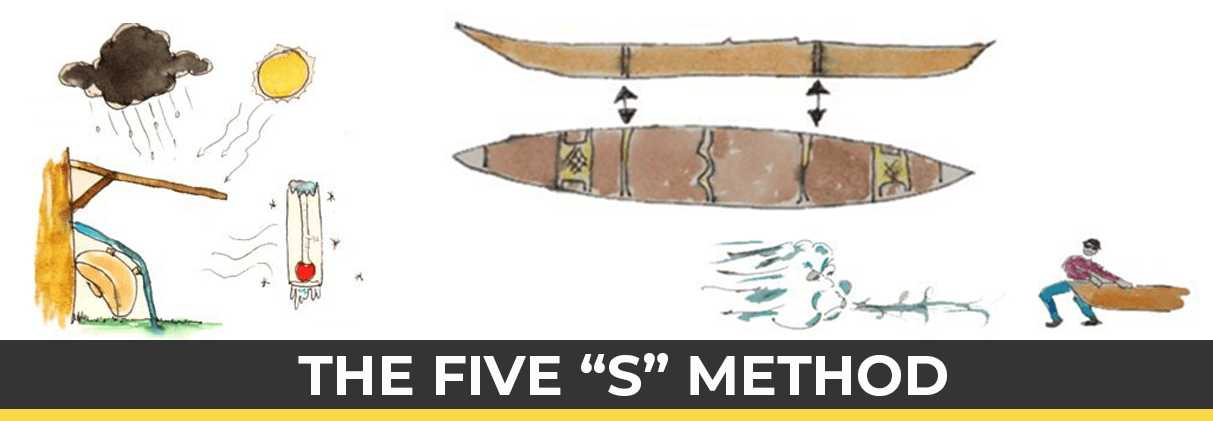Smart Storage Keeps Boats Healthy
For some of us, storing our canoe or kayak is as simple as dropping it off alongside the garage or outbuilding or cradling it on a couple of saw horses somewhere out of the way. If we are especially caring we might even toss a tarp over our favorite watercraft and be done with it.
While that is basically all you really need to do, it may be more prudent to take a bit more time to think out optimum ways to store your single or fleet of boats. My suggestion is to consider using the five "S" method when devising a storage arrangement.

Five "S" Method for Smartly Storing Boats
These points take into consideration most of the main concerns about storing boats for any climatic conditions and challenges. Collectively they may extend the life of your boat, and will at least offer some protection.
These five points of smart storage for canoes and kayaks are:
- Shade
- Shelter
- Structure
- Strength
- Security
Shade
This is pretty basic and straightforward. Pretty much anyone whose uses outdoor equipment made from plastic or vinyl has been warned about exposure to ultraviolet radiation and what it can do to the finish, and ultimately the composition, of your boat. Our gear receives enough exposure during transit and use that it should at least be protected when being stored.
Therefore, simply put, keep your boat in the shade. How that shade is provided calls upon another "S" or two.
Shelter
Many a boat, at least up here in the Northland, spends several months lying alongside a garage or outbuilding. A tarp can serve as a flexible roof over your boat while even something as simple as a lean-to roof serves the purpose better.
The main thing about a shelter as simple as an overhanging roof or eave is whether or not it will keep snow and ice off your boat. There are enough incidents of boats being damaged by chunks of ice crashing down onto boats during spring thaw to caution someone about flimsy or poorly-sloped roofs.

Even if under a roof, a boat is even better protected by the use of a tarp. I find it better to have a shallow air space between the covering and the surface of the boat. This can be achieved by laying a few slats of wood along the hull or deck of the boat and supporting the tarp on top of these airstrips. A tarp is usually not very secure if allowed to hang freely but if you can secure the tarp to protect the boat without touching it, I feel that is a preferred method.
I also strongly suggest covering your cockpit and making sure your hatches are secure, even if you are covering your boat with a tarp. It will keep the insides cleaner, drier and free of critters seeking shelter from the cold of winter. There is nothing worse than uncovering a boat in spring and seeing a dark, thick stew of leaves, twigs and water brewing inside your boat.
If you are going to store a boat outside in regions where freezing temperatures will be common throughout winter (or even if there is a chance it will dip below freezing) make sure your boat is dry and will stay dry. The destructive forces of freezing water in confined or restricted places is well documented. Even layers of the hull or deck can separate if water trapped between layers is frozen and forced to expand within such confining spaces.
Structure & Strength
Many of the above problems are mitigated if you can keep your boat stored inside. If that space is unheated, it will still be necessary to keep the boat free of moisture. The main thing to consider for interior storage is the structure of the boat (its weight and the layout of the cross members, either bulkheads or thwarts) as these are the support points from which you can hang your boat via straps or set up on work benches or other floor/wall racks.

Unless you have ample ceiling height in your garage, you may have to hang your boat from the wall. This is a pretty easy task that actually doesn’t take up too much room since the boat can be hung fairly high above the floor level. Typically the boat is supported at a point on the hull where there is a bulkhead (kayak) or thwart or seat frame (canoe). The boat can be suspended from those areas via nylon straps (I prefer 2" wide straps, but 1" are strong enough for most boats).
Check Out the Kayak Storage Guide >>
When being hung from a wall, each support straps form a sling loop through which the bow and stern are fed. The strap ends are fitted with a "D" ring and both ends of the loop are slipped down over an adequately sized/weighted screw hook (or big nail). When removing the boat from its sling cradle, support the boat on your shoulder or arm and remove that first supporting strap from around the boat.
Now slide the boat forward so the other end is free from its cradle loop. When storing again you can slide one end of the boat into the loop left hanging, thereby freeing up both hands to maneuver the boat into place and re-hook the other loop when the boat is in position.
Loops can be also be suspended from the ceiling. Using a pulley system, you drive in, hook up your boat and then lift it up, off your roof and into storage position high above the garage and your vehicle all with the pull of a few lines.
The key to any suspended or rack storage is where that support hits the boat. The strongest points on most hulls lie along an area circumscribing where the bulkheads (kayak) or thwarts (canoe) are located inside the hull. On rotomolded and other boats that may not have a bulkhead, use an area about 2/3 the distance back from the bow to the cockpit for the front support area and about 1/3 of the way back from the back of the cockpit. The physical strength characteristics of a column come into play when considering a kayak so unless the boat is loaded down with gear, support can be given almost anywhere along the hull. Some boats are stored in factories on their ends – not a good idea for long-term home storage.
It’s a given that the strength of hanging boats is only as strong as the beams or wall, and hardware, used in the process.
Security
It is sadly amazing how many different ways thieves have found to steal kayaks and canoes – from paddling off at demo days to outright trespassing into one’s backyard. Securing your boat, even in what seems to be pretty secure and private areas is always a good idea.
There are kayak security cable systems designed to keep boats on car racks that can also be used around the storage area. Any securing cable will work in such situations. I had three double kayaks cabled to a pine tree on a remote island in Kodiak for three years without any incident at all. Of course bears don’t pick locks or cut cables and even itinerate thieves aren’t going to go to the trouble of flying out a stolen boat on a floatplane or risk a fifty mile open ocean crossing just to complete the heist.
Most security issues will be someone taking a boat from a cabin or back yard or through a natural threat – high winds.

Against the first threat – cables and kayak locks or locked storage areas are the only way to deter most thieves. The second threat is often underestimated; it’s an error only realized after the damage is done.
If you underestimate the wind...
A fellow kayaker typically stored his boats outside, under the protection of a mid-level deck behind his house. He opted not to secure his boats and for years stored them without incident. One afternoon of unseasonably high winds he came home to find that one of his boats had been pushed along the entire length of his lawn (the trail looking like that of a huge sidewinder snake) only to be stopped by the metal corner pole of his cyclone fence. If you’ve seen an aluminum canoe wrapped around a boulder in a river, you know what his fiberglass kayak looked like embraced around that fence pole.
Always tie down your boats if there’s any chance the wind may get at it!
A friend who conducted kayak tours on the island of Kauai was once confronted with securing his fleet of kayaks from the approaching winds of a typhoon-like storm. Considering the fact that anything he might tie his boats to could in turn be blown away, he laid them out in his open yard behind the protection of his house. He filled each boat with water up to the coaming and storage areas. Water weighs eight pounds per gallon so you can imagine just how heavy each boat became (ever try lifting a flooded boat up out of the water?). Literally steady as rocks, the boats survived the storm without damage.
While you may never face such extreme measures, consider the above five “S” approach and keep your boat “healthy” for a long time.
Related Articles
Don’t get stuck next spring with gear that’s not ready to go. So many of us finish one thing and move…
In this video, the team at Austin Kayak show you how to rebuild your keel if you have created a hole…
In this video, Ken Whiting of PaddleTV is talking about how to care for the latex gaskets on your dry…
Watch Jimmy Blakeney explain proper care and maintenance for and Inflatable Standup Paddleboard. From…



